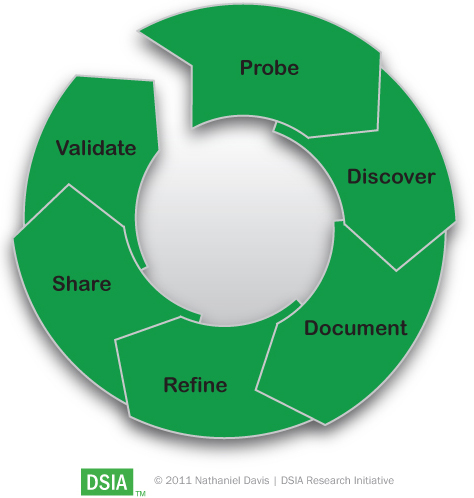In 2009, I became intrigued by the basic concept of practice and sought to understand how practitioners of information architecture might go beyond acquiring skill or proficiency to systematically discovering and sustaining discipline. In general, we might define these two terms as follows:
- practice—Repetitive behavior for the purpose of producing and sustaining discipline.
- discipline—Rules, methods, or processes, and predictable results—that is, work products—that derive from practice.
By the time I began my research, the field of information architecture had already discovered valuable rules that contributed to a discipline of information architecture. However, the IA community’s lack of a framework of IA practice has fueled some disparities in the discipline of information architecture—from the epistemology, or what we claim to know, of information architecture to processes and a constructive vocabulary. Such a framework would aid us in evolving a discipline with greater efficiency and coordination in the future. As a result, I had to decide whether to adopt an existing practice framework from a different field or propose one of my own. Always looking for an opportunity to apply my own theories, I was inspired to craft a new practice framework.
My efforts morphed into a type of IA management research that I call practice modeling—an inquiry into a formal approach to practice that promotes discipline and is agnostic of any professional occupation.
In this column, I’d like to highlight three useful insights of practice modeling that offer guidance on how to begin practicing information architecture with greater accountability. With these ideas in place, our identifying ourselves as practitioners has greater meaning—enabling the evaluation of our overall proficiency and establishing credibility for the discipline that we bring to a project and an organization.
Insight 1: Practice Targets Unique Competencies
Of course, you need not be an information architect![]() to practice information architecture. In fact, the majority of you who are reading this column probably call yourselves a UX Designer or UX Architect. However, your jobs typically require you to oversee or perform information architecture duties. Regardless of your title and your main responsibilities within your organization, if you want to practice information architecture effectively, you should ground your perspective on a solid idea of what practice means.
to practice information architecture. In fact, the majority of you who are reading this column probably call yourselves a UX Designer or UX Architect. However, your jobs typically require you to oversee or perform information architecture duties. Regardless of your title and your main responsibilities within your organization, if you want to practice information architecture effectively, you should ground your perspective on a solid idea of what practice means.
While the definition of practice that I provided earlier might be a useful enough definition as definitions go, it does not specifically mention the range of repetitive behaviors that would help optimize one’s approach to practice. For this, we need a more descriptive definition:
practice—“The collective behavior of intentional empirical probing around an area of interest, whereby the contribution of documentation of discovery enables consensus that builds and reinforces discipline around such behaviors.”—from the DSIA Research Initiative
I introduced this definition in a presentation that I gave at the 2010 IA Summit. I know it doesn’t quite roll off the tongue—technical definitions rarely do. However, this more descriptive definition expresses several points that our first definition doesn’t include. The idea of primary importance is the formal exploration of competencies, or what the DSIA definition refers to as an area of interest.![]() With the exception of specialists, practitioners usually take on several areas of interest.
With the exception of specialists, practitioners usually take on several areas of interest.
If you study my previous UXmatters columns, you will see that areas of interest are critical because they help frame a practice. These define the main focus of professionals’ work and immediately provide scope for all of their efforts. Further, with careful consideration, the mere mention of an area of interest should imply a value proposition. To see an example, read “Framing the Practice of Information Architecture,” in which I discuss what I consider to be the primary areas of interest of information architecture.
I’ve also summarized the primary areas of interest for UX design in my DSIA Research Initiative article “UX Design Practice Verticals.”![]() To perceive the real value of information architecture, a review of the broader domain of UX design is necessary, because it’s important to understand how it relates to the other practice verticals that contribute to the design and development of computing interfaces. The areas of interest of information architecture (IA) are
To perceive the real value of information architecture, a review of the broader domain of UX design is necessary, because it’s important to understand how it relates to the other practice verticals that contribute to the design and development of computing interfaces. The areas of interest of information architecture (IA) are
- information navigation
- information organization
- information relationship
- IA management
- IA strategy
- IA research
Insight 2: Practice Is About Behavior
Becoming effective at practicing information architecture—or any other profession—requires more than acquiring knowledge and pursuing the profession’s primary areas of interest. How we acquire competency in those areas of interest—through a set of professional behaviors—determines how proficient we become through discipline. Thus, if you choose to take the path of a practitioner, by definition, you’ll need to hold yourself accountable for a rigor of practice that cultivates discipline. This is valuable both to you and the organization for which you work.
Whether you gain discipline on the job or through formal training or an apprenticeship, the practice methodology of the DSIA Research Initiative suggests that the set of behaviors that produce discipline is the same for any of these educational paths. In this section, I’ll summarize the subject domains![]() of this methodology.
of this methodology.

1. Probe for new knowledge and opportunities.
“Seek and you will find.”—Matthew 7:7
Practitioners demonstrate a passion for probing thought, in the hope of finding some new aspect of an area of interest within a practice that extends their knowledge. This is probably the one behavior of practice that most reflects a mindset that encourages practitioners never to rest on their laurels.
As you take on your next assignment, your intention should be to explore something new—like a navigational behavior that you had never anticipated, a unique informational relationship, or a new requirement for managing a complex domain.
